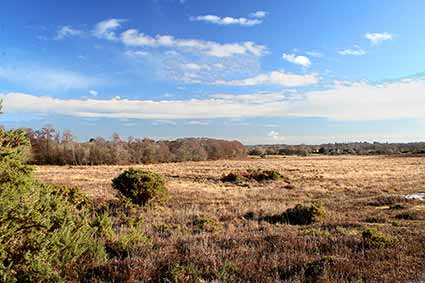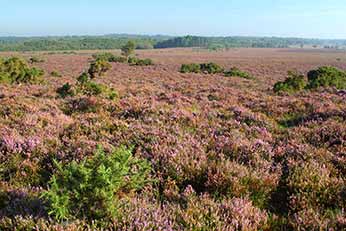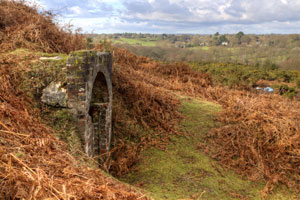Rifle Volunteer Corps and their 19th Century / Victorian, New Forest Rifle Ranges
(In part from a paper by John Reid: The Rifle Volunteer Corps of Alresford, 1859-1908)

Ordnance Survey maps from the second half of the 19th century show a number of volunteer rifle ranges scattered about the New Forest, whilst traces of these reminders of war-torn former years can still be found in some of the New Forest's woods and on the heaths.
Brockenhurst's rifle range (A), for example, was located to the west of the village centre, and ran from close to North and South Weirs, to terminate on, and later near, Five Thorns Hill.
The Lyndhurst rifle range (B) was on White Moor, to the east of the village; whilst in the north-west of the area, Colonel Vandeleur established a rifle range close to Long Bottom (C), just below Hampton Ridge.
Burley, too, had its own Rifle Range, this to the west of the village at Strodgemoor Bottom, between Castle Hill and Crow Hill (D).
The volunteer forces have a fascinating history
In early 1859, it was generally believed that the Emperor Napoleon III of France had ambitions to dominate Europe, as his uncle had fifty years before; and among other moves was planning to invade southern England. If this came about, Hampshire would, of course, be in the front line.
It was feared that, if the Royal Navy was unable to prevent a French landing, the Regular Army with a large proportion of its strength in India and elsewhere on colonial service would be too small to repel the invaders.
Much alarmed, the public demanded action. Lord Palmerston, the Prime Minister, ordered the strengthening of Portsmouth and other south coast defences - Hurst Castle was strengthened in the 1850s; and HMS Warrior was launched in 1860 for the purpose of patrolling the Channel.
At the same time the government was urged to re-form the Volunteer forces, which had been raised previously between 1793 and 1813, but had then been largely disbanded, and the formation of a Volunteer Rifle Force was subsequently agreed.

Each local Corps would be independent and would meet its own expenses for uniform, drill hall, drill sergeants, rifle range, etc. The government would, however, supply Long Enfield muzzle loading rifles and make grants based on attendance and standard of marksmanship.
The Volunteers were not initially intended as front line soldiers. The emphasis was on proficient marksmanship with the rifle. Volunteer sharp-shooters would operate in small units, and their intimate knowledge of their districts would provide them with a huge advantage over the enemy. Drill was kept to a minimum and uniform was as simple as possible.
There was no shortage of public spirited volunteers and within a short time local, Corps had been formed over the whole country. The main response came from 'the numerous useful and intelligent class of clerks and shopkeepers, with officers from the gentlemen of the district.'
In December 1861, the 1st Administrative Battalion Hants Rifle Volunteers was created to establish uniformity in training amongst the six independent companies that had come into being in the Winchester area. Apart from his weekly local training, a Volunteer was expected to attend eight official exercises each four months under regular Army instructors.

the hillside at Long Bottom
The crushing defeat of France by Prussia in 1871 sent another wave of alarm through Britain. The Regular Army was reformed, the Volunteers were armed with a better rifle, the breech loading Snyder, and in 1877 were issued with a smarter uniform, more in line with that of the County Regiment.
The role of the Volunteers was gradually brought closer-to that of the Regular Army. In 1880 the 1st Administrative Battalion was consolidated with the 1st Hampshire Rifle Volunteer Corps, in which the individual Companies lost their independent status and became lettered Companies.
Eventually, in 1908, the citizen army of the Rifle Volunteers, which had expanded greatly during the Boer War, was absorbed, along with the County Militia, into the Territorial Forces (renamed the Territorial Army in 1921). The 1st Hants provided the 4th Battalion the Hampshire Regiment, which was organised, equipped and trained on Regular Army lines and was intended in the event of war to relieve one of the regular Battalions which would then be available to fight in France.
Find out more about the New Forest's Volunteer Rifle Ranges
Reference:
The Rifle Volunteer Corps of Alresford, 1859-1908
More links
Other related links
Search this site

Sadly, 58 animals were killed - 35 ponies, 13 cows, 8 donkeys and 2 sheep, whilst a further 32 were injured - 3 pigs, 9 donkeys, 11 cows and 9 ponies.
(Forty-three accidents occurred in daylight, 15 at twilight and 101 in the dark. Twenty-seven accidents were not reported by the driver involved).
Here's just one horrific example - Three donkeys killed in collision with van at notorious New Forest blackspot (Advertiser and Times)

